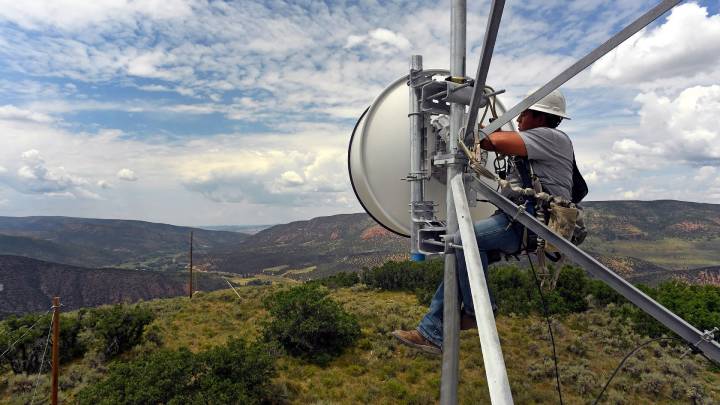
Constellations spoke with David Witkowski, co-chair of the deployment working group at the Institute of Electrical and Electronics Engineers (IEEE) Future Networks Technical Committee. The committee is a futurist group designing a roadmap for the direction of communications technology. He spoke to Constellations about how keeping up with the rapid advances in communications technology is the biggest challenge affecting satellite, terrestrial and Wi-Fi networks.
As the communications ecosystem evolves, different technologies will connect people to the internet, according to Witkowski, and satellite is one of those. Over the years, there have been numerous attempts to use satellites for broadband communications. Prior to the past few years, “they’ve not really, no pun intended, gotten off the ground,” said Witkowski. “But satellite has always been one of the things that IEEE believed would be in the mix.”
As evidence of the growing recognition of satellite broadband, the group that sets the standards for things like LTE, the 4G network, New Radio and the 5G network, has incorporated satellite in the development of future releases of the 3rd Generation Partnership Project (3GPP) standard.
‘The Fifth Utility’
Today LEO broadband constellations are feeding ground networks and will become a key contributing element to terrestrial communications. Witkowski believes broadband will become as much a part of everyday life as electricity, gas, water and sanitation. For this reason, he refers to it as the “fifth utility” and like all utilities, life would be extremely difficult without it.
“People who live in other countries who don’t have connection will see the digital divide that prevents them from participating in life in the 21st century [expand],” said Witkowski. “There is a lot of value in bringing broadband to those locations and it is easier to do so with a satellite network than it is to do it with terrestrial networks.”
While terrestrial fiber optic cable networks provide reliable, symmetrical connectivity, they are also expensive to deploy. Witkowski cited the high costs of permitting, construction and environmental impact studies. “If you’re going to run fiber in a trench along the ground out in the woods, you might have concerns about impacting a habitat of an endangered species,” he said. “Satellite can service those people directly just because it’s over their heads at all times.”
Some communities living in rural areas in the U.S. and abroad are already using satellite services, such as Starlink, to create community co-ops for themselves. They distribute the Starlink data throughout their community using a variety of technologies, including ethernet, Wi-Fi and fixed wireless data communications before ultimately getting the data to their devices.
Yet, while the digital divide is expanding in some areas in others, satellite broadband is shrinking it. The question is no longer whether satellites can serve those people but whether the LEO network has the capacity to handle the growing amount of traffic.
“Scalability is an issue,” Witkowski said. “But I think keeping up with the pace of technology is probably one of the biggest headwinds that a satellite constellation faces.”

A Snapshot in Time
Witkowski is an avid follower of satellite launches but commented that there’s no way to send a technician to upgrade the platform once the rocket leaves the launch pad.
“When you launch a satellite, you’re taking a snapshot in time, and it is frozen at that point. There’s very little that you can do to upgrade that satellite, other than some software changes.” That snapshot only changes when you add a new standard, like 6G for example. Then, according to Witkowski, existing 5G satellites must be either end of life or continue to operate at 5G until the satellite fails.
Constellations asked the futurist about roaming between satellite and terrestrial networks and if standards were being developed to hasten this development. Witkowski explained that standards work is occurring in two areas. On the cellular side, 3GPP is looking at how 5G can support direct from space to ground communications. On the Wi-Fi side, the 8211 standard is being enhanced to support offload, which is the ability, while on a call, to seamlessly roam across satellite, terrestrial and Wi-Fi networks.
Witkowski recalled how a colleague, a professor in Sweden, talked about how Northern Europe is
moving away from fiber as a fixed delivery method because of the costs and the complexity. They prefer
to use wireless because it is quicker, easier to deploy and less environmentally impactful. Witkowski
went on to point out that before writing off fiber, there are many tradeoffs to consider. Chief among
them is network stability vs cost. “Fiber is a great technology. It is very symmetrical, and it’s very, very
stable, but it is very expensive to deploy,” he concluded.

Hundreds of Thousands of Data Streams
Following on this network thread, Constellations asked Witkowski if there’ll be a role for direct-to-device communications in the future and if Apple had proven the capability. Witkowski explained that Apple’s implementation of direct-to-device is a limited bandwidth solution, best suited to emergency text messaging. He believes that direct-to-device is better proved out by the recent AT&T-AST SpaceMobile test, which was a 4G test that generated a 10-megabit connection down to a device. “That was pretty compelling,” Witkowski said, “because again, while 10 megabits is not broadband, at least you would have some multimedia capability.” The biggest problem that you get into with that at scale is the ability of the network to deal with large numbers of users.
He further explained, a satellite orbiting over a major metro area potentially sees tens of thousands, if not hundreds of thousands, of users simultaneously with potentially thousands of devices trying to talk to it at the same time. He compared the situation to a news conference with 10,000 reporters shouting questions at the same time. “That’s kind of what a satellite experience is in the course of its daily life. It’s constantly dealing with…what an engineer would call uplink management, uplink contention. And that’s the biggest thing that I think we deal with” in terms of communications scalability.
Witkowski concluded the discussion by admitting that there are many challenges and there are many solutions that the satellite industry will have to engineer to suit the problem it’s trying to solve.
To hear more about future communications standards, the challenges to the digital divide and the role of mobile network operators, click here.
